& Construction

Integrated BIM tools, including Revit, AutoCAD, and Civil 3D
& Manufacturing

Professional CAD/CAM tools built on Inventor and AutoCAD

Integrated BIM tools, including Revit, AutoCAD, and Civil 3D

Professional CAD/CAM tools built on Inventor and AutoCAD
Transcript
00:03
The objective in transient control is to reduce the magnitude (and if possible, the frequency) of the pressure disturbance.
00:10
This means avoiding more sudden changes that will exacerbate the existing transient event.
00:16
Slowly opening and closing valves and slowly starting and stopping pumps can be effective in controlling transients.
00:23
Additionally, implementing certain devices in a network
00:27
can alleviate the effects of pressure waves by releasing and replenishing excess positive and negative pressure.
00:33
The optimal method to alleviate a surge varies depending on the situation.
00:37
In this example, a Closed Surge Tank is implemented.
00:41
To begin, open the network.
00:43
From the Model Group window, expand the TS Model group.
00:47
Open the TS Network and TS Control by double clicking TS Network, or by dragging it onto the main window.
00:54
Next, set the properties for the surge tank.
00:58
Use the Find Network Objects tool to locate the node with asset ID Surge Tank 1.
01:05
In the toolbar, click the Properties icon to open the Properties window for the node.
01:11
Scroll down to find Transient-Surge Protection Device
01:15
and click the plus sign (+) next to it to expand the Transient-Surge Protection Device Page.
01:20
Select the Enable Surge (SPD) checkbox.
01:23
InfoWorks TS allows for several different types of devices to be represented.
01:29
Expand the Surge Protection drop-down and select Closed Surge Tank.
01:34
Set the Inflow and Outflow Diameters to 50.8mm, set the Tank Volume to 10m3 and set the Initial Tank Depth to 0.5m.
01:45
To continue, set the Inflow Loss Coefficient to 20, the Outflow Loss Coefficient to 1, the Expansion Constant to 1.3,
01:54
the Initial Gas Volume to 5m, and the Tank Diameter to 1m.
01:59
Commit your changes to the database.
02:04
Now, create a new run.
02:06
In the Model Group, right-click Run Group and select New > Run.
02:11
In the Schedule Hydraulic Run dialog, in the Title field, name this run “TS-Pump Trip with SPD”.
02:21
From the Model Group window, drag InfoWorks TS Network, InfoWorks TS Control,
02:27
and Average Demand into the Network, Control, and Demand Diagram boxes.
02:33
Also, select the box next to Experimental.
02:37
In the Run Type group box, expand the drop-down and select InfoWorks TS to open the InfoWorks TS Options dialog.
02:46
Change the Transient simulation start to 2 May 2022 at 06:00 and the Duration to 30 seconds.
02:54
Leave the remaining options as the defaults and click OK.
02:58
Back in the Schedule Hydraulic Run dialog, at the bottom of the Run Parameters group box,
03:04
expand the drop-down and select Simulation Options.
03:08
Click the Options button next to it to open the Simulation Options window.
03:14
In the Description column, locate the Advise on Hydraulic Transients option.
03:19
In the same row, in the Default column, deselect the checkbox so that the Value column says Yes.
03:26
Click OK to close the window.
03:29
Click Save, and then Run.
03:33
In the Model Group, double-click the TS-Pump Trip SPD Transient run to open it in the GeoPlan.
03:41
Right-click the TS-Pump Trip Transient run, and click Open As.
03:46
In the Select Results dialog, select Open as alternative results for comparison.
03:52
Click OK.
03:55
Use the Graph tool to graph the flow through pipe SV002.Surge Check.1,
04:00
and in the Select what to graph for dialog, enable Graph alternate results.
04:05
Although the flow is still flashy, there is still flow through this pipe when using the surge tank.
04:11
Now, graph the pressure through the Surge Check node.
04:14
Notice that the surge protection device significantly dampens the transient.
Video transcript
00:03
The objective in transient control is to reduce the magnitude (and if possible, the frequency) of the pressure disturbance.
00:10
This means avoiding more sudden changes that will exacerbate the existing transient event.
00:16
Slowly opening and closing valves and slowly starting and stopping pumps can be effective in controlling transients.
00:23
Additionally, implementing certain devices in a network
00:27
can alleviate the effects of pressure waves by releasing and replenishing excess positive and negative pressure.
00:33
The optimal method to alleviate a surge varies depending on the situation.
00:37
In this example, a Closed Surge Tank is implemented.
00:41
To begin, open the network.
00:43
From the Model Group window, expand the TS Model group.
00:47
Open the TS Network and TS Control by double clicking TS Network, or by dragging it onto the main window.
00:54
Next, set the properties for the surge tank.
00:58
Use the Find Network Objects tool to locate the node with asset ID Surge Tank 1.
01:05
In the toolbar, click the Properties icon to open the Properties window for the node.
01:11
Scroll down to find Transient-Surge Protection Device
01:15
and click the plus sign (+) next to it to expand the Transient-Surge Protection Device Page.
01:20
Select the Enable Surge (SPD) checkbox.
01:23
InfoWorks TS allows for several different types of devices to be represented.
01:29
Expand the Surge Protection drop-down and select Closed Surge Tank.
01:34
Set the Inflow and Outflow Diameters to 50.8mm, set the Tank Volume to 10m3 and set the Initial Tank Depth to 0.5m.
01:45
To continue, set the Inflow Loss Coefficient to 20, the Outflow Loss Coefficient to 1, the Expansion Constant to 1.3,
01:54
the Initial Gas Volume to 5m, and the Tank Diameter to 1m.
01:59
Commit your changes to the database.
02:04
Now, create a new run.
02:06
In the Model Group, right-click Run Group and select New > Run.
02:11
In the Schedule Hydraulic Run dialog, in the Title field, name this run “TS-Pump Trip with SPD”.
02:21
From the Model Group window, drag InfoWorks TS Network, InfoWorks TS Control,
02:27
and Average Demand into the Network, Control, and Demand Diagram boxes.
02:33
Also, select the box next to Experimental.
02:37
In the Run Type group box, expand the drop-down and select InfoWorks TS to open the InfoWorks TS Options dialog.
02:46
Change the Transient simulation start to 2 May 2022 at 06:00 and the Duration to 30 seconds.
02:54
Leave the remaining options as the defaults and click OK.
02:58
Back in the Schedule Hydraulic Run dialog, at the bottom of the Run Parameters group box,
03:04
expand the drop-down and select Simulation Options.
03:08
Click the Options button next to it to open the Simulation Options window.
03:14
In the Description column, locate the Advise on Hydraulic Transients option.
03:19
In the same row, in the Default column, deselect the checkbox so that the Value column says Yes.
03:26
Click OK to close the window.
03:29
Click Save, and then Run.
03:33
In the Model Group, double-click the TS-Pump Trip SPD Transient run to open it in the GeoPlan.
03:41
Right-click the TS-Pump Trip Transient run, and click Open As.
03:46
In the Select Results dialog, select Open as alternative results for comparison.
03:52
Click OK.
03:55
Use the Graph tool to graph the flow through pipe SV002.Surge Check.1,
04:00
and in the Select what to graph for dialog, enable Graph alternate results.
04:05
Although the flow is still flashy, there is still flow through this pipe when using the surge tank.
04:11
Now, graph the pressure through the Surge Check node.
04:14
Notice that the surge protection device significantly dampens the transient.
The objective in transient control is to reduce the magnitude (and if possible, the frequency) of the pressure disturbance. This means avoiding more sudden changes that will exacerbate the existing transient event. Slowly opening and closing valves and slowly starting and stopping pumps can be effective in controlling transients. Additionally, implementing certain devices in a network can alleviate the effects of pressure waves by releasing and replenishing excess positive and negative pressure.
The optimal method to alleviate a surge varies depending on the situation. In this example, a Closed Surge Tank is implemented.
To set the properties for the surge tank:
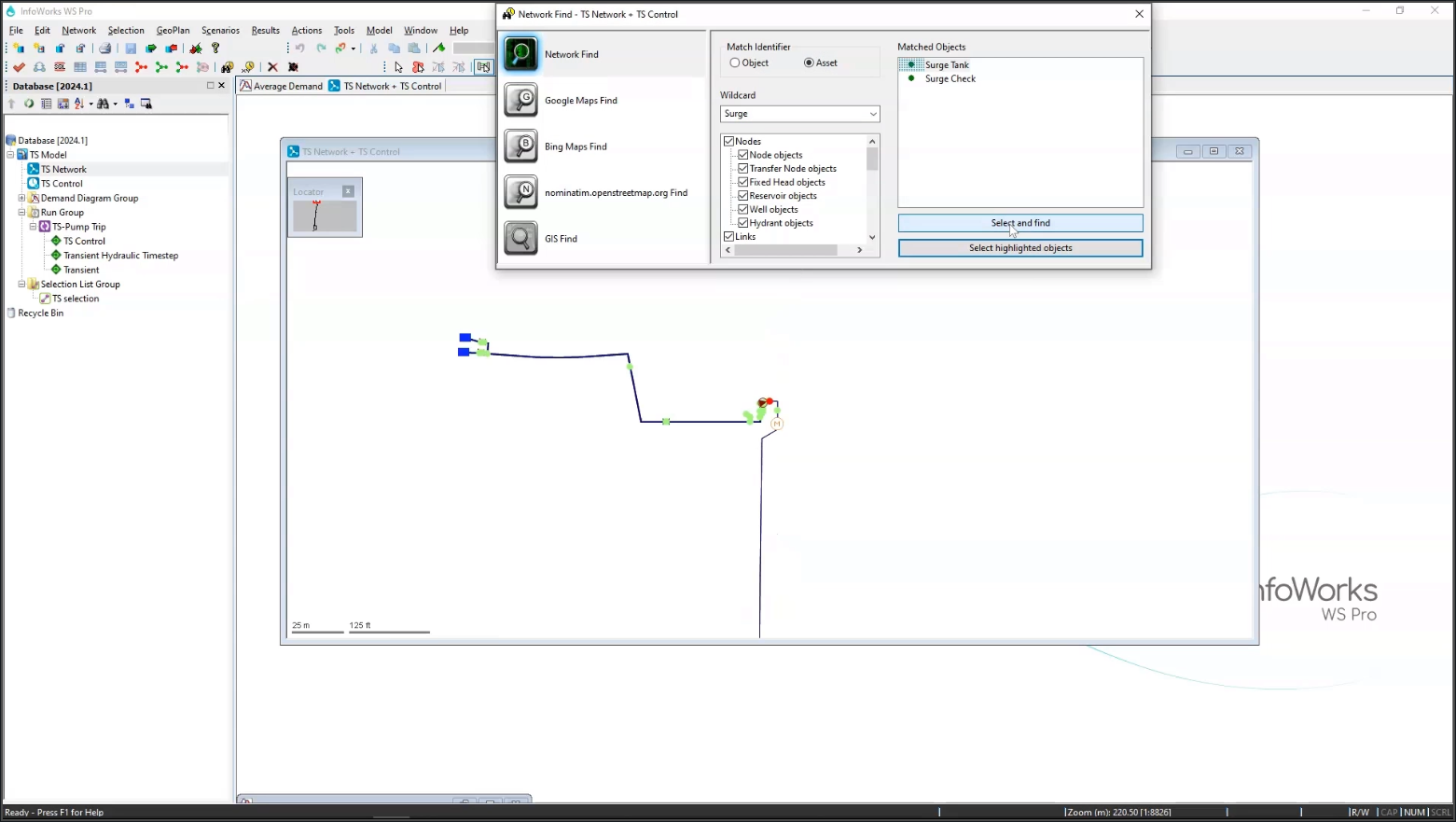
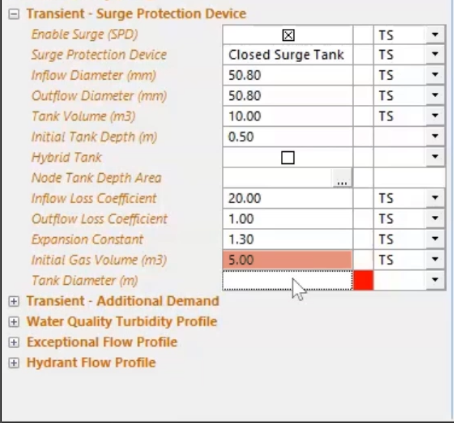
To create a new run:
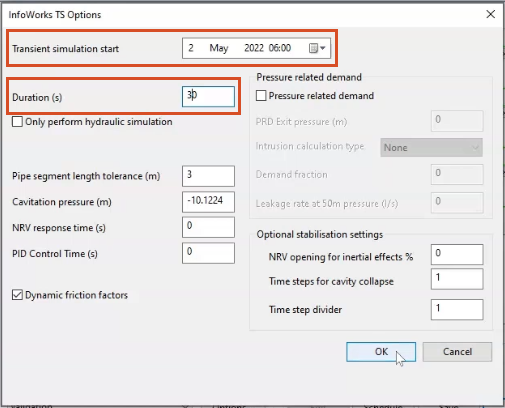
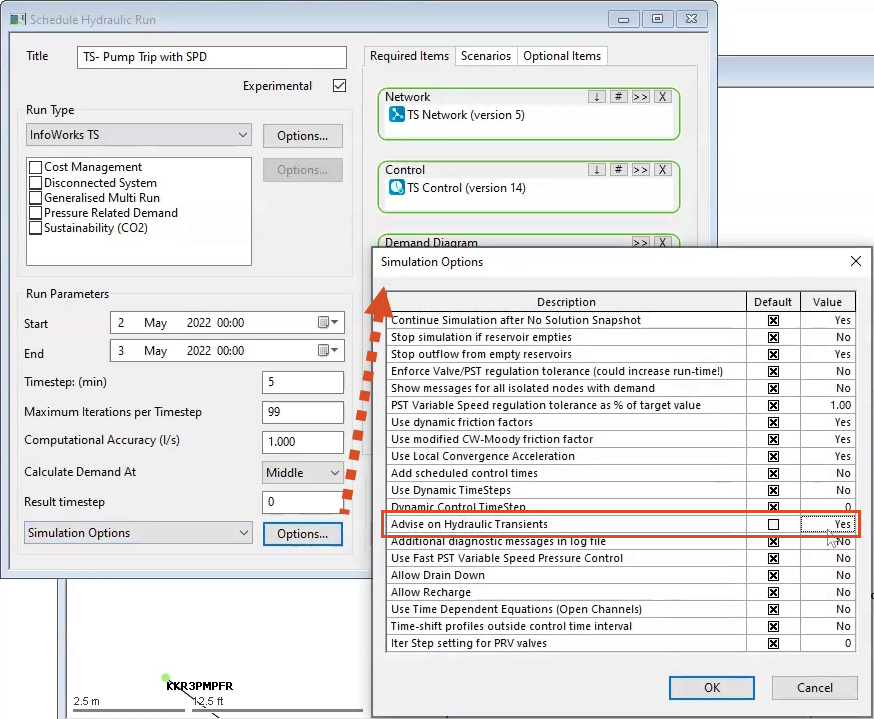
To compare these results:
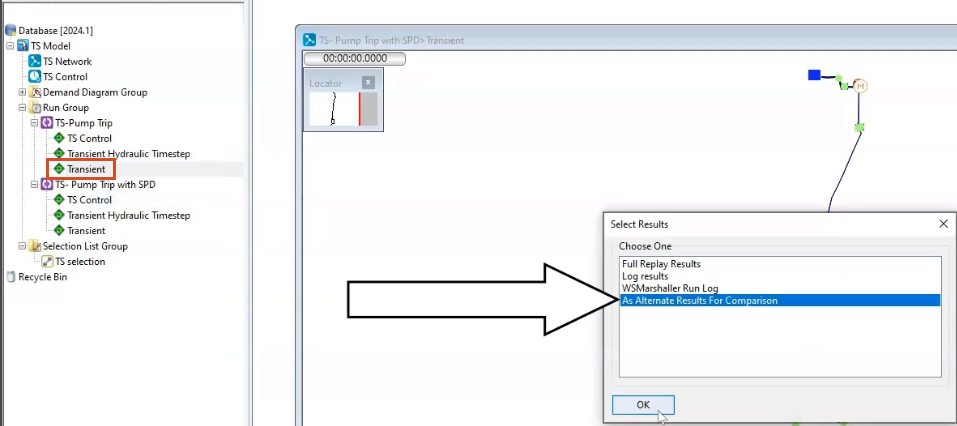
To graph the flow through pipe SV002.Surge Check.1:
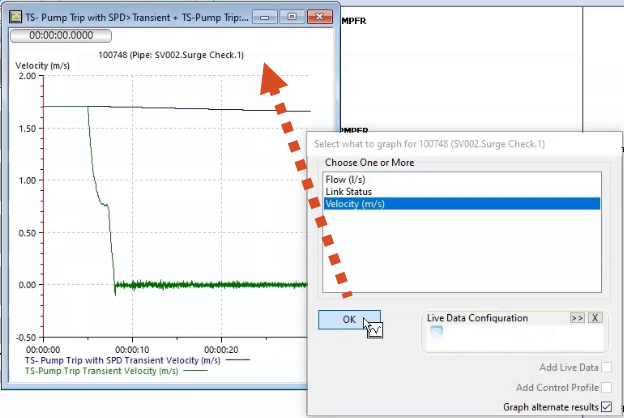
Although the flow is still flashy, there is still flow through this pipe when using the surge tank.
Graph the pressure through the Surge Check node:
Notice that the surge protection device (surge tank) significantly dampens the transient:
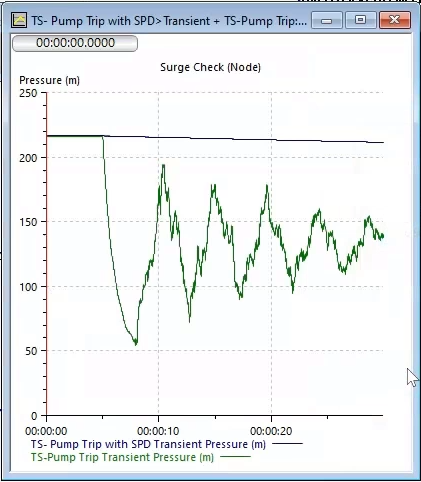
How to buy
Privacy | Do not sell or share my personal information | Cookie preferences | Report noncompliance | Terms of use | Legal | © 2025 Autodesk Inc. All rights reserved
Sign in to start learning
Sign in for unlimited free access to all learning content.Save your progress
Take assessments
Receive personalized recommendations
May we collect and use your data?
Learn more about the Third Party Services we use and our Privacy Statement.May we collect and use your data to tailor your experience?
Explore the benefits of a customized experience by managing your privacy settings for this site or visit our Privacy Statement to learn more about your options.